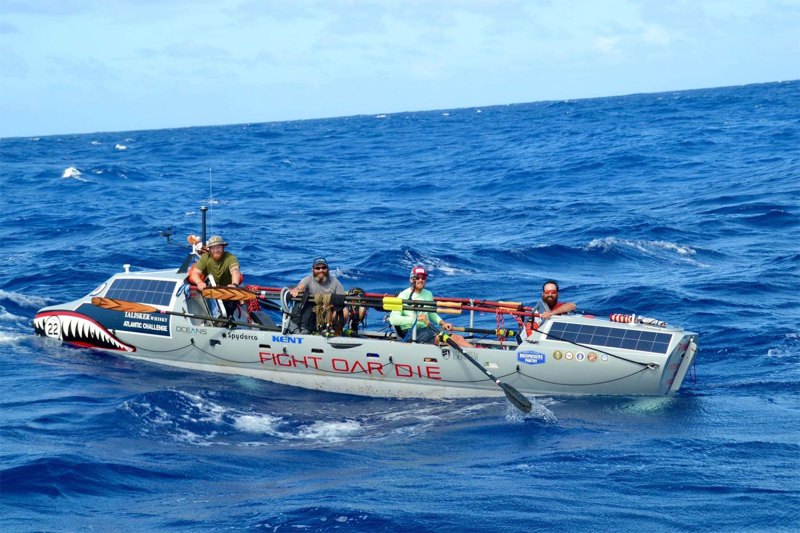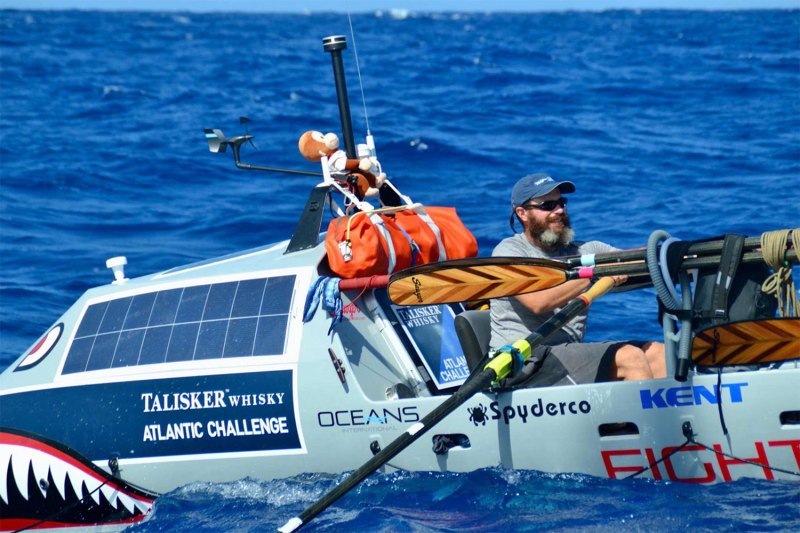What does it take to board a 28-foot state-of-the-art rowboat and literally row across the Atlantic Ocean? Remember, it’s basically not much more than a lifeboat except individuals and teams volunteer to compete in this annual event.
On December 12, 2019, 35 teams varying in size from solo to 4-person teams set out from La Gomera in the Canary Islands in the Talisker Whisky Atlantic Challenge. Before they set foot back on land on the island of Antigua, they will row over 3,000 miles in this grueling journey.
Did we mention that it was just 28-feet long and it’s state-of-the-art? But it’s still a rowboat! And sorry Gilligan, this is far from a three-hour tour.

I traveled to La Gomera ahead of the race and got to spend time with the 2019 team and even had the opportunity climb aboard their home for the foreseeable future and explore the deck with rowing platforms, berths (sleeping area), and bathroom (spoiler alert: it’s a bucket).
Fight Oar Die is an all-American, all-veteran team that toed the line for the first time in 2018. That team was comprised of four United States Army veterans. This year’s team consists of four new veterans: Carl Christensen (Skipper), John Fannin, Luke Holton, and Evan Stratton. The team is made up of three branches of the military this round: the United States Navy, Army, and Marines. You can follow the team here.
Since this was a new crew of veterans competing under the Fight Oar Die team name, I wanted to connect with someone that had participated to find out what it really takes to complete this arduous race aboard a floating tiny house. We caught up with Bryant Knight, who is the founder and president of Fight Oar Die and participated in the 2018 race. He created the organization to increase the awareness and raise money for veterans. Having completed the demanding, non-stop adventure, we got firsthand insight from this retired Special Forces Army veteran about what it took for him and his team to finish the race.
The Manual: What does it take to compete in the world’s greatest rowing race?
Bryant Knight: I think the first thing is that you have to tell yourself you’re going to row an ocean. In my opinion the mental game is the biggest hurdle because that sits on your mind through the whole process. We spent over a year preparing for the race. Getting sponsorships, building a nonprofit, having our boat built, training, logistics, etc. and all the time telling yourself you’re going to get in a 28-foot boat and row across the Atlantic with three other guys you barely know. For Fight Oar Die we went at it the only way we knew and that was plan for the Talisker Whisky Atlantic Challenge as if it were a military operation. None of us knew what we were doing when preparing for the race but we knew how to plan, we knew how to create training programs, and we knew how to execute. When we started we had no boat, none of us had ever crossed the ocean, most of us were out of shape, and we knew very little about the race.

TM: What did a typical day look like during your trip across the Atlantic?
BK: We worked on a three hour on, three hour off shift with two rowers behind the oars at all times. During a typical shift, you come out from the cabin and anchor into the jack line for safety. There’s this rhythmic way to move around the boat when changing rowers so not to tip your boat. If you were smart, you had made your food while ending the last shift so you wouldn’t have to wait for your food to hydrate. You eat, drink water, and then you begin your shift. About every three to four days, we would replenish our fresh water from our water maker. That would give us time to wash ourselves, and any clothing that needed to be cleaned. A fresh prince is such a motivator because salt is everywhere.
TM: What was the hardest part of the journey?
BK: Hmm, all of it, hah. Salt sores on your butt is not fun, especially when you’re sitting in the rowing seat for so much time. About the second week at sea, we got caught in the doldrums and the the sea held us there for days. We had to eventually employ our sea anchor so as not to get pushed the opposite way we needed to go. We fought for hours rowing the boat before we made the decision to do it and it was demoralizing. We were in such a good spot in the race and we didn’t want to lose ground. The sea anchor is a great tool to hold you and keep you from drifting the wrong way and I’ve never met an ocean rower that wanted to do it.
TM: What was the best part of your trip?
BK: The mornings. Being able to watch the sun come up with a cup of coffee on the open ocean is a gift that few get to witness. Being in the moment and just taking the time to think about where you are on this planet was a real joy.

TM: What did you eat in a typical day?
BK: Backpackers Pantry is our food sponsor. So, for the most part, it was dehydrated foods. We also took a lot of peanut butter and mixed it with honey. Our bodies were starved for carbohydrates so we picked out high energy foods for the trip. Each one of us took sweets. And for me, it was chocolate. I gave my self a little bit of chocolate after most of the shifts behind the oars.
TM: What was the scariest part of the trip?
BK: There are definitely some scary moments out there. But, if you prepare for contingencies to potential situations, you can control your fear. There were a few days the Atlantic gave us some big seas and so we bobbed around like a cork, tied into the boat, and working hard to keep your heading. Getting hit with a broadside wave in our boat in the middle of the night feels like getting blindsided by an NFL linebacker. This didn’t happen to us but it is a real possibility.
TM: How did you train for the race?
BK: You spend a lot of time in the gym, particularly the rowing machine. You do a lot a core strengthening and you try not to injure yourself while doing it. When we had our boat, “Woobie,” finished, we took her to Mobile, Alabama and trained in Mobile Bay and eventually the Gulf of Mexico. That was just three weeks of training and our only time that we trained on our boat before we shipped her to La Gomera.
TM: Did the race bring you closer to your teammates?
BK: For the most part, yes. Like all teams, you have to work together to reach your goals. When you spend that much time in a confined space, you’ve really get the opportunity to get to know your crew. That doesn’t mean that our crossing didn’t go without argument or controversy. It did.
TM: What was your charity?
BK: When we started Fight Oar Die (FOD), all we really wanted to do was bring some awareness towards veteran’s mental health. Every one of us had been on multiple combat deployments and we all had known someone who had succumbed to suicide within our respected units. So the nonprofit, Fight Oar Die, was created. Our focus is to put a new group of veterans in the race each year. We’ve got teams lined up to 2021.
TM: Did your team participate in any studies ahead of the race?
BK: We partnered with the University of Denver, Sturm Specialty of Military Psychology. The program trains students in the doctoral years to directly work with veterans while in school. It’s the only program like it in the United States. The students are also working with the FOD teams to study performance in stressful situations, like ocean rowing. The hope for us is to provide something tangible to help veterans cope with stress. We also have just partnered with the Marcus Institute for Brain Health that works with veterans with TBI (traumatic brain injury) related injuries.
TM: Would you do it again?
BK: Yes! I will do it again.
TM: According to the team’s website, here are a few statistics worth mentioning for all of you following along.
- Each team will row in excess of 1.5 million oar strokes over a race.
- More people have climbed Everest than rowed an ocean.
- The waves the rowers will experience can measure up to 20-feet high.
- Each rower needs to aim to consume 10 liters of water per day.
- Rowers burn in excess of 5,000 calories per day.
- Each rower loses on average more than 26 pounds while crossing the Atlantic.


